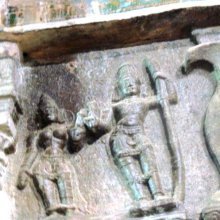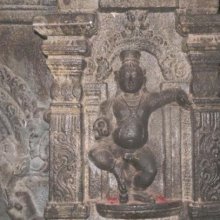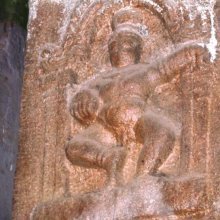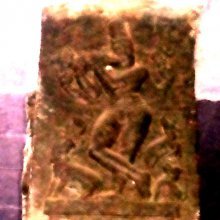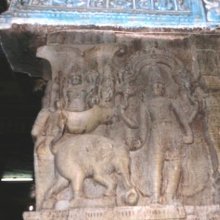Gopala, Gopāla, Go-pala: 29 definitions
Introduction:
Gopala means something in Buddhism, Pali, Hinduism, Sanskrit, the history of ancient India, Marathi. If you want to know the exact meaning, history, etymology or English translation of this term then check out the descriptions on this page. Add your comment or reference to a book if you want to contribute to this summary article.
Images (photo gallery)
(+4 more images available)
In Hinduism
Vaishnavism (Vaishava dharma)
Source: Wikipedia: Vaishnava dharmaGopāla (गोपाल, “cow protector”) is the infant/child form of Lord Krishna, the Cowherd Boy who enchanted the Cowherd Maidens (Gopinis) with the divine sound of his flute, attracting even Kāmadeva (the Hindu god of love and passion). Historically one of the earliest forms of worship in Krishnaism or Vaishnava dharma, it is believed to be a key element of the early history of the worship of Krishna.
Source: ISKCON Press: GlossaryGopāla (गोपाल).—A name of Kṛṣṇa as a young boy; the Supreme Lord Kṛṣṇa, who protects the cows.
Source: Pure Bhakti: Brhad BhagavatamrtamGopāla (गोपाल) refers to:—A name of Kṛṣṇa as a young cowherd; the protector of the cows. (cf. Glossary page from Śrī Bṛhad-bhāgavatāmṛta).

Vaishnava (वैष्णव, vaiṣṇava) or vaishnavism (vaiṣṇavism) represents a tradition of Hinduism worshipping Vishnu as the supreme Lord. Similar to the Shaktism and Shaivism traditions, Vaishnavism also developed as an individual movement, famous for its exposition of the dashavatara (‘ten avatars of Vishnu’).
Purana and Itihasa (epic history)
Source: Cologne Digital Sanskrit Dictionaries: The Purana Index1a) Gopāla (गोपाल).—A name of Kṛṣṇa.*
- * Brahmāṇḍa-purāṇa III. 33. 8; Viṣṇu-purāṇa V. 20. 49.
1b) (Gopas)—Ābhiras and Dasyus;1 chief weapons of, staves and cudgels.2
Source: JatLand: List of Mahabharata people and placesGopāla (गोपाल) is a name mentioned in the Mahābhārata (cf. ) and represents one of the many proper names used for people and places. Note: The Mahābhārata (mentioning Gopāla) is a Sanskrit epic poem consisting of 100,000 ślokas (metrical verses) and is over 2000 years old.

The Purana (पुराण, purāṇas) refers to Sanskrit literature preserving ancient India’s vast cultural history, including historical legends, religious ceremonies, various arts and sciences. The eighteen mahapuranas total over 400,000 shlokas (metrical couplets) and date to at least several centuries BCE.
Vyakarana (Sanskrit grammar)
Source: Wikisource: A dictionary of Sanskrit grammarGopāla (गोपाल).—(देव (deva)) known more by the nickname of मन्नुदेव (mannudeva) or मन्तुदेव (mantudeva) who lived in the eighteenth century and wrote several commentary works on well-known grammatical treatises such as the Vaiyakaranabhusanasara, Laghusabdendusekhara, Paribhasendusekhara etc. He is believed to have written a treatise on Ganasutras also; (2) a grammarian different from the above मन्नुदेव (mannudeva) who has written an explanatory work on the Pratisakhyas;.(3) a scholar of grammar, different from the above who is believed to have written a gloss named Visamarthadipika on the Sarasvata Vyakarana at the end of the sixteenth century.

Vyakarana (व्याकरण, vyākaraṇa) refers to Sanskrit grammar and represents one of the six additional sciences (vedanga) to be studied along with the Vedas. Vyakarana concerns itself with the rules of Sanskrit grammar and linguistic analysis in order to establish the correct context of words and sentences.
General definition (in Hinduism)
Source: WikiPedia: HinduismGopāla (गोपाल): Name of Krishna indicating his origin as a god of flocks and herds.
In Buddhism
Tibetan Buddhism (Vajrayana or tantric Buddhism)
Source: OSU Press: Cakrasamvara SamadhiGopāla (गोपाल) or Gopāleśvara refers to one of the “eight passionless ones” (Aṣṭavaitarāga or Aṣṭavītarāga), according to the Guru Mandala Worship (maṇḍalārcana) ritual often performed in combination with the Cakrasaṃvara Samādhi, which refers to the primary pūjā and sādhanā practice of Newah Mahāyāna-Vajrayāna Buddhists in Nepal.

Tibetan Buddhism includes schools such as Nyingma, Kadampa, Kagyu and Gelug. Their primary canon of literature is divided in two broad categories: The Kangyur, which consists of Buddha’s words, and the Tengyur, which includes commentaries from various sources. Esotericism and tantra techniques (vajrayāna) are collected indepently.
General definition (in Buddhism)
Source: academia.edu: The Chronological History of BuddhismKing Gopala (70-110 CE) and Odantapuri.—Vihara Gaudavaho of Vakpatiraja records that Kanyakubja king Yashovarman killed the king of Bengal. Taranatha says that there was no king in Bengal for many years. Later, people elected Gopala as the king of Bengal at the end of 1st century. Thus, Gopala founded the rule of Pala dynasty. King Gopala built Odantapuri Vihara.
King Gopala also conquered Magadha and ruled for 45 years. According to Indradutta, Gopala became king immediately after the death of Acharya Charin (Krishnacharya?) whereas Kshemendrabhadra says that Gopala became king seven years later.
India history and geography
Source: Google Books: Medieval Orissa: A Socio-economic StudyGōpāḷa refers to a “milkman” and represents one of the occupational groups commonly found in Townships or Urban centers (nagari) in ancient India (Medieval Orissa).—An example (of Township) is provided by the Nagari plates of Anangabhima III, dated A.D. 1230, which describe an assigned township which contained four large houses of the dimension of royal residences and thirty other houses. The occupational groups present in the settlement were [e.g., a milkman (gōpāḷa)]. The range of occupations is large, some of them being rural in character. The context in which the township (or Urban centres—nagari) is assigned suggest that nagaris in such cases were perhaps extended villages, formed out of a cluster of several contiguous villages and thus assuming physical and consequently, economic dimensions much larger than those of an ordinary village settlement.
Source: archive.org: Personal and geographical names in the Gupta inscriptionsGopāla (गोपाल) is an example of a Vaiṣṇavite name mentioned in the Gupta inscriptions. Classification of personal names according to deities (e.g., from Vaiṣṇavism) were sometimes used by more than one person and somehow seem to have been popular. The Gupta empire (r. 3rd-century CE), founded by Śrī Gupta, covered much of ancient India and embraced the Dharmic religions such as Hinduism, Buddhism and Jainism. Derivation of personal names (e.g., Gopāla) during the rule of the Guptas followed patterns such as tribes, places, rivers and mountains.
Source: What is India: Epigraphia Indica volume XXXI (1955-56)Gopāla is the name of a king from Nalapura hailing from the Yajvapāla dynasty, as mentioned in inscriptions from Baṅglā (1281 A.D.). The Dāhi grant mentions Nalapura-pati Gopāla as one of the rulers vanquished by Mallāya who was probably a general of Vīravarman.
Source: Cologne Digital Sanskrit Dictionaries: Indian Epigraphical GlossaryGopāla.—(IE 8-8), a milkman or cowherd. Note: gopāla is defined in the “Indian epigraphical glossary” as it can be found on ancient inscriptions commonly written in Sanskrit, Prakrit or Dravidian languages.

The history of India traces the identification of countries, villages, towns and other regions of India, as well as mythology, zoology, royal dynasties, rulers, tribes, local festivities and traditions and regional languages. Ancient India enjoyed religious freedom and encourages the path of Dharma, a concept common to Buddhism, Hinduism, and Jainism.
Languages of India and abroad
Pali-English dictionary
Source: BuddhaSasana: Concise Pali-English Dictionarygopāla : (m.) a cowherd.

Pali is the language of the Tipiṭaka, which is the sacred canon of Theravāda Buddhism and contains much of the Buddha’s speech. Closeley related to Sanskrit, both languages are used interchangeably between religions.
Marathi-English dictionary
Source: DDSA: The Molesworth Marathi and English Dictionarygōpāla (गोपाल).—m (S) pop. gōpāḷa m A cowherd. 2 A king. 3 A name of kṛṣṇa. 4 A caste or an individual of it. They are leapers and tumblers. They break stones with the bare arm, lift great weights, and perform feats of strength.
Source: DDSA: The Aryabhusan school dictionary, Marathi-Englishgōpāla (गोपाल) [-ḷa, -ळ].—m A cowherd. A name of kṛṣṇa. A king.
Marathi is an Indo-European language having over 70 million native speakers people in (predominantly) Maharashtra India. Marathi, like many other Indo-Aryan languages, evolved from early forms of Prakrit, which itself is a subset of Sanskrit, one of the most ancient languages of the world.
Sanskrit dictionary
Source: DDSA: The practical Sanskrit-English dictionaryGopāla (गोपाल).—
1) a cowherd; Manusmṛti 4.253.
2) a king.
3) an epithet of Śiva.
4) an epithet of Kṛṣṇa. °धानी (dhānī) a cow-pen, cow-shed.
Derivable forms: gopālaḥ (गोपालः).
Gopāla is a Sanskrit compound consisting of the terms go and pāla (पाल).
Source: Cologne Digital Sanskrit Dictionaries: Edgerton Buddhist Hybrid Sanskrit DictionaryGopāla (गोपाल).—(= Pali id.), name of a yakṣa: Mahā-Māyūrī 103; 237.1.
Source: Cologne Digital Sanskrit Dictionaries: Shabda-Sagara Sanskrit-English DictionaryGopāla (गोपाल).—m.
(-laḥ) 1. A King, a sovereign. 2. A cowherd. 3. A name of Krishna. E. go the earth, &c. and pāla who preserves or protects. gāṃ bhūmiṃ paśubhedaṃ vā pālayati pāli aṇ .
Source: Cologne Digital Sanskrit Dictionaries: Benfey Sanskrit-English DictionaryGopāla (गोपाल).—I. m. 1. a cowherd, [Mānavadharmaśāstra] 4, 251. 2. a king, [Pañcatantra] i. [distich] 249. 3. a proper name. Ii. f. lī, a proper name.
Gopāla is a Sanskrit compound consisting of the terms go and pāla (पाल).
Source: Cologne Digital Sanskrit Dictionaries: Cappeller Sanskrit-English DictionaryGopāla (गोपाल).—[masculine] cowherd; prince, king; [Epithet] of Kṛṣṇa.
Source: Cologne Digital Sanskrit Dictionaries: Aufrecht Catalogus Catalogorum1) Gopāla (गोपाल) as mentioned in Aufrecht’s Catalogus Catalogorum:—See Gārgyagopāla.
2) Gopāla (गोपाल):—minister of Kīrtivarmadeva. See introduction to Prabodhacandrodaya.
3) Gopāla (गोपाल):—one of the gurus of Nīlakaṇṭha (Bhāratabhāvadīpa). Oxf. 1^b.
4) Gopāla (गोपाल):—guru of Rāmacandra (Kālanirṇayadīpikā). W. p. 331.
5) Gopāla (गोपाल):—son of Kāvajī, brother of Sūrya and Rāmakṛṣṇa, father of Gaṇeśa (Jātakālaṃkāra 1614). L. 2443.
6) Gopāla (गोपाल):—father of Raṅgabhaṭṭa, father of Viṣṇu Paṇḍita, father of Candraśekhara (Śiśupālavadhaṭīkā). L. 3040.
7) Gopāla (गोपाल):—son of Nārāyaṇa, father of Padmanābha Dīkṣita (Prayogadarpaṇa). L. 1775.
8) Gopāla (गोपाल):—father of Viśvanātha (Vrataprakāśa). Oxf. 283^b.
9) Gopāla (गोपाल):—a writer on dharma, is mentioned by Śrīdatta in Śrāddhakalpa. L. 1924.
10) Gopāla (गोपाल):—father of Rāmānanda, grandfather of Jānakīnandana (Vṛttadarpaṇa) wrote a
—[commentary] on the Kaṇādasūtra and a Kāvyakaumudī L. 2038.
11) Gopāla (गोपाल):—Caitanyacaritāmṛta. Proceed. Asb. 1865, 139.
12) Gopāla (गोपाल):—wrote in 1606: Dravyaguṇa med. He quotes the Dravyaguṇa by Cakra and Nārāyaṇa. L. 2927.
13) Gopāla (गोपाल):—Pañcopākhyāna. B. 2, 130.
14) Gopāla (गोपाल):—Bhāsvatīṭīkā jy. Oudh. 1877, 28.
15) Gopāla (गोपाल):—One of the compilers of the Vivādārṇavabhaṅga. Peters. 2, 53.
16) Gopāla (गोपाल):—Vivekāmṛta, vedānta. Oudh. Iv, 17.
17) Gopāla (गोपाल):—Śālavaṃśanṛpamuktāvalī. Lahore. 4.
18) Gopāla (गोपाल):—Śulbasūtraṭīkā. Np. Ii, 2. Iii, 96.
19) Gopāla (गोपाल):—Sārasvataṭīkā Viṣamārthadīpikā [grammatical] B. 3, 30.
20) Gopāla (गोपाल):—Śrautakārīkāḥ Baudh. read Bu7hler 539.
21) Gopāla (गोपाल):—Rāsāryaguchāḥ.
22) Gopāla (गोपाल):—son of Kāhnajī: Jātakālaṃkāra.
23) Gopāla (गोपाल):—called also vopadeva, son of Nṛsiṃha, grandson of Gopāla, pupil of Meṅganātha, composed in 1438: Rasamañjarīvikāsa.
24) Gopāla (गोपाल):—Āśvalāyanagṛhyakārikāvalī.
25) Gopāla (गोपाल):—Kuṇḍamṛdaṅga.
26) Gopāla (गोपाल):—son of Narasiṃha, pupil of Raṅgarāja: Āpastambaśulbarahasyaprakāśa.
—[commentary] on Āpastamba’s Darśapūrṇamāsaprāyaścittasūtra. Darśapūrṇamāseṣṭi Āpast. Darśapūrṇamāseṣṭipaddhati Baudh. Nakṣatreṣṭiprayoga Baudh.
27) Gopāla (गोपाल):—Nānārthasaṃgraha lex.
28) Gopāla (गोपाल):—Baudhāyanaśrautakārikā.
29) Gopāla (गोपाल):—son of Durgādāsa: Tattvaprakāśikā Devīmāhātmyaṭīkā.
30) Gopāla (गोपाल):—son of Sukhadhara: Ratirahasyaṭīkā.
Source: Cologne Digital Sanskrit Dictionaries: Monier-Williams Sanskrit-English Dictionary1) Gopāla (गोपाल):—[=go-pāla] [from go] m. (proparox, [Pāṇini 6-2, 78]) a cowherd, [Vājasaneyi-saṃhitā xxx, 11; Śatapatha-brāhmaṇa iv; Manu-smṛti iv, 253; Yājñavalkya] etc. (ifc. f(ā). , [Rāmāyaṇa ii, 67, 25])
2) [v.s. ...] ‘earth-protector’, a king (and ‘cowherd’), [Pañcatantra]
3) [v.s. ...] (= -pati) Kṛṣṇa, [Mahābhārata iii, 15530]
4) [v.s. ...] Śiva, [cf. Lexicographers, esp. such as amarasiṃha, halāyudha, hemacandra, etc.]
5) [v.s. ...] Name of a demon causing fever, [Harivaṃśa 9556]
6) [v.s. ...] of a Nāga, [Buddhist literature]
7) [v.s. ...] of a minister of king Bimbi-sāra, [ib.]
8) [v.s. ...] of a king, [ib.]
9) [v.s. ...] of a general of king Kīrti-varman, [Prabodha-candrodaya i, 4]
10) [v.s. ...] of a scholar, [Pratāparudrīya [Scholiast or Commentator]]
11) [v.s. ...] = -pālaka q.v.
Source: Cologne Digital Sanskrit Dictionaries: Yates Sanskrit-English DictionaryGopāla (गोपाल):—[go-pāla] (laḥ) 1. m. A king; a cowherd; Krishna.
Source: DDSA: Paia-sadda-mahannavo; a comprehensive Prakrit Hindi dictionary (S)Gopāla (गोपाल) in the Sanskrit language is related to the Prakrit word: Govāla.
[Sanskrit to German]
Sanskrit, also spelled संस्कृतम् (saṃskṛtam), is an ancient language of India commonly seen as the grandmother of the Indo-European language family (even English!). Closely allied with Prakrit and Pali, Sanskrit is more exhaustive in both grammar and terms and has the most extensive collection of literature in the world, greatly surpassing its sister-languages Greek and Latin.
Kannada-English dictionary
Source: Alar: Kannada-English corpusGōpāla (ಗೋಪಾಲ):—
1) [noun] one who tends cows; a cowherd.
2) [noun] an epithet of Lord Křṣṇa, a cowherd.
3) [noun] Śiva.
4) [noun] the act of begging; beggary.
5) [noun] a religious sect the members of which live on alms.
6) [noun] the vessel, basket or other container used for receiving alms.
7) [noun] that which is of little or no value.
--- OR ---
Gōpāḷa (ಗೋಪಾಳ):—[noun] = ಗೋಪಾಲ [gopala].
Kannada is a Dravidian language (as opposed to the Indo-European language family) mainly spoken in the southwestern region of India.
Nepali dictionary
Source: unoes: Nepali-English DictionaryGopāla (गोपाल):—n. 1. cowherd; 2. Mythol. a god, Krishna;
Nepali is the primary language of the Nepalese people counting almost 20 million native speakers. The country of Nepal is situated in the Himalaya mountain range to the north of India.
See also (Relevant definitions)
Partial matches: Go, Paala, Pala.
Starts with (+105): Gopala acarya, Gopala avasathika, Gopala bhatta, Gopala bhatta guha, Gopala cakravartin, Gopala kavi, Gopala mishra, Gopala nyayapancanana, Gopala nyayapancanana bhattacarya, Gopala pandita, Gopala paramahamsaparivrajakacarya, Gopala sarasvati, Gopala sharman, Gopala siddhanta, Gopala siddhantavagisha, Gopala yogin, Gopalabhatta, Gopalabutti, Gopalacaitanya, Gopalacakravartin.
Ends with (+2): Abalagopala, Agopala, Balagopala, Bhatta gopala, Bhattagopala, Gandagopala, Jayagopala, Jegopala, Kandagopala, Keligopala, Lauhityabhattagopala, Madanagopala, Maunagopala, Nandgopala, Rajanaka gopala, Ramagopala, Samtanagopala, Santanagopala, Sategopala, Tirthagopala.
Full-text (+323): Gopalamatha, Gopalakeshava, Gaupalayana, Gaupalapashupalika, Gopalacampu, Gopalakalpa, Gopaladhanipulasa, Gopalarahasya, Gopalatapini, Gopalacakravartin, Gopalatirtha, Gopalatapaniyopanishad, Gopalamishra, Gopalabhatta, Gopalakelicandrika, Gopalasahi, Gopalaprasada, Gopalavarman, Gopalagiri, Gopalapura.
Relevant text
Search found 77 books and stories containing Gopala, Gopāla, Go-pala, Gōpāla, Go-pāla, Gōpāḷa; (plurals include: Gopalas, Gopālas, palas, Gōpālas, pālas, Gōpāḷas). You can also click to the full overview containing English textual excerpts. Below are direct links for the most relevant articles:
Brihad Bhagavatamrita (commentary) (by Śrī Śrīmad Bhaktivedānta Nārāyana Gosvāmī Mahārāja)
Verse 2.1.63 < [Chapter 1 - Vairāgya (renunciation)]
Verse 1.2.20 < [Chapter 2 - Divya (the celestial plane)]
Verse 2.1.92 < [Chapter 1 - Vairāgya (renunciation)]
Garga Samhita (English) (by Danavir Goswami)
Verse 1.4.50 < [Chapter 4 - Description of Questions About the Lord’s Appearance]
Verse 4.14.3 < [Chapter 14 - The Story of the Jālandharīs]
Verse 5.19.8 < [Chapter 19 - The Festival on Śrī Kṛṣṇa Return]
Chaitanya Bhagavata (by Bhumipati Dāsa)
Verse 2.24.15 < [Chapter 24 - The Lord Displays His Universal Form to Advaita]
Verse 1.9.154 < [Chapter 9 - Nityānanda’s Childhood Pastimes and Travels to Holy Places]
Verse 1.5.18 < [Chapter 5 - Eating the Mendicant Brāhmaṇa’s Offerings]
Sahitya-kaumudi by Baladeva Vidyabhushana (by Gaurapada Dāsa)
Text 9.41 [snake diagram] < [Chapter 9 - Ornaments of Sound]
Text 4.66 < [Chapter 4 - First-rate Poetry]
Text 11.53 < [Chapter 11 - Additional Ornaments]
Puranic encyclopaedia (by Vettam Mani)
List of Mahabharata people and places (by Laxman Burdak)
Related products

